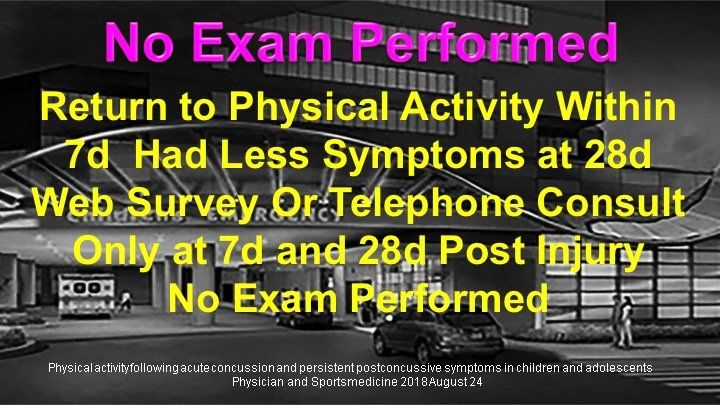Exercise Decreases Concussion Symptoms However .....
Comment by Dr. Mladenoff
This study reveals that light aerobic exercise initiated by 7 days post concussion can have a positive influence on reduction of symptoms at 28 days.
No pre and post physical examinations were performed, there is no discussion of radiography performed nor is there discussion of any prenosological evaluation.
Altered brain circulation is one of the immediate sequelae of head trauma, therefore improving circulation with aerobic exercise is an eventual treatment strategy. The study does not indicate any evaluation for circulatory disturbance of the brain, nor any circulatory functional parameters such as arterial elasticity.
There is also no discussion of the sequential steps for Return To Participation guidelines as recommended from CDC and Berlin Congress of Sports Concussion Assessment.
Recall that there are six stages of return to participation. The first to be initiated when the patient is symptom free for 24 hours before initiating any physical activity that elevates heart rate above the resting heart rate level. Most ER departments and clinicians in general are not cognicant of the gradual and systematic increase in physical exertion as part of the therapeutic recovery from a concussion.
There are no Return To Learn cognitive guidelines evaluated in this study either.
Relying on the evaluation of reduction in clinical symptomatology as the determination of recovery from head trauma is simplistic, inappropriate and may lead to long term neurological deficits.
This study is encouraging about the benefits of aerobic exercise but not at the compromise of limited to no functional neurological assessment.
Physical activity following acute concussion and persistent postconcussive symptoms in children and adolescents. Physician and Sportsmedicine 2018 August 24
Abstract: The management of concussion in pediatric patients has always been guided by treatment guidelines that have been drawn from consensus statements rather than clinical research projects. Grool and colleagues conducted a clinical research project on an early return to physical activity and its effect on post-concussion symptoms.
The study enrolled 3063 pediatric patients, age 5.0 to 17.99 years of age who presented to one of nine Pediatric Emergency Research Centers in Canada. 2413 patients completed the primary outcome for exposure. 1677 patients (69.5%) instituted some level of early physical activity, including light aerobic exercise (n=795 or 32.9 %), sport-specific exercise (n=214 or 8.9%), non-contact drills (n=143 or 5.9%), full-contact practice (n=106 or 4.4%), or full competition (n=419 or 17.4%), while 736 (30.5%) instituted no physical activity. Patients were evaluated by a web-based survey or a telephone-based survey at days 7 and 28 after their initial visit, and their symptoms were evaluated by using the Post Concussive Symptom Inventory (PCSI).
Early return to physical activity was associated with a lower risk of Persistent Post-Concussive Syndrome (PPCS) than in patients reporting no physical activity at 28 days (24.6% vs 43.5%, Absolute risk difference, (ARD), 18.9% (95% CI 14.7-23.0%). Among the sub-group of patients who were symptomatic at day 28 (n=803), PPCS was more present in the patients that reported no physical activity, (n=584: PPCS 52.9%), than those with light aerobic activity (N=494 [46.4%; ARD, 6.5%; 95% CI 5.7-12.5%], moderate activity [n=176 (38.6%; ARD, 14.3%; 95% CI 5.9%-22.2%], or full contact activity [n=133 (36.1%; ARD, 16.8%; 95% CI 7.5%- 25.5%].
Therefore, in patients aged 5 to 18 years with acute concussion, a return to physical activity within 7 days of acute injury was associated with less symptoms at 28 days than in patients who had a period of prolonged rest rather than an early return to physical activity.
Abstract: The management of concussion in pediatric patients has always been guided by treatment guidelines that have been drawn from consensus statements rather than clinical research projects. Grool and colleagues conducted a clinical research project on an early return to physical activity and its effect on post-concussion symptoms.
The study enrolled 3063 pediatric patients, age 5.0 to 17.99 years of age who presented to one of nine Pediatric Emergency Research Centers in Canada. 2413 patients completed the primary outcome for exposure. 1677 patients (69.5%) instituted some level of early physical activity, including light aerobic exercise (n=795 or 32.9 %), sport-specific exercise (n=214 or 8.9%), non-contact drills (n=143 or 5.9%), full-contact practice (n=106 or 4.4%), or full competition (n=419 or 17.4%), while 736 (30.5%) instituted no physical activity. Patients were evaluated by a web-based survey or a telephone-based survey at days 7 and 28 after their initial visit, and their symptoms were evaluated by using the Post Concussive Symptom Inventory (PCSI).
Early return to physical activity was associated with a lower risk of Persistent Post-Concussive Syndrome (PPCS) than in patients reporting no physical activity at 28 days (24.6% vs 43.5%, Absolute risk difference, (ARD), 18.9% (95% CI 14.7-23.0%). Among the sub-group of patients who were symptomatic at day 28 (n=803), PPCS was more present in the patients that reported no physical activity, (n=584: PPCS 52.9%), than those with light aerobic activity (N=494 [46.4%; ARD, 6.5%; 95% CI 5.7-12.5%], moderate activity [n=176 (38.6%; ARD, 14.3%; 95% CI 5.9%-22.2%], or full contact activity [n=133 (36.1%; ARD, 16.8%; 95% CI 7.5%- 25.5%].
Therefore, in patients aged 5 to 18 years with acute concussion, a return to physical activity within 7 days of acute injury was associated with less symptoms at 28 days than in patients who had a period of prolonged rest rather than an early return to physical activity.

